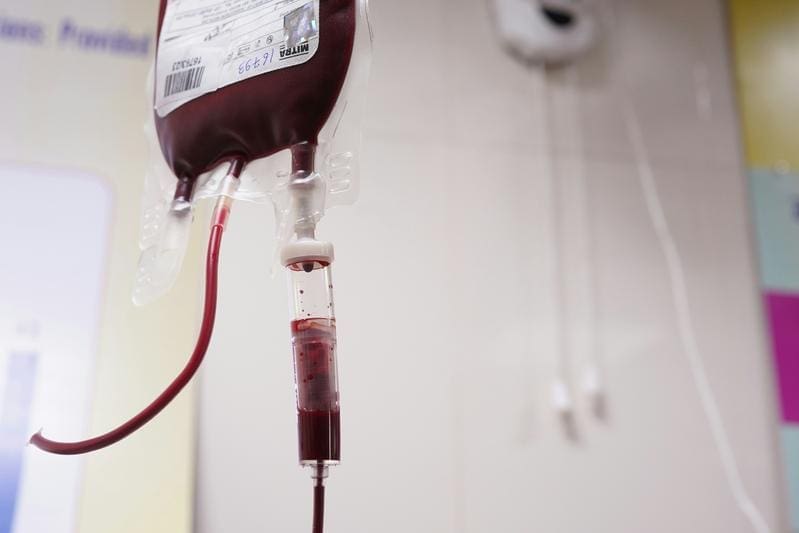New findings bring artificial blood one step closer
Researchers from the University of Konstanz and Queen Mary University of London have made a significant advance that could make the production of red blood cells in the laboratory more efficient. Their discovery, published in the prestigious journal Science Signaling, sheds light on the role of the chemokine CXCL12 and its receptor CXCR4 in nuclear ejection – a crucial step in the development of red blood cells.
Every day, around 15,000 units of blood are needed in Germany, which until now have come almost exclusively from voluntary donors. In view of the limited availability and the need to meet rare blood groups or specific requirements, scientists have been researching the artificial production of blood for decades. “Blood production in the human body is a highly complex process that takes place in the bone marrow,” explains Dr. Julia Gutjahr, biologist at the Institute of Cellular Biology and Immunology Thurgau at the University of Konstanz. “Only when we understand every single step exactly can we replicate this process in the laboratory.”
A central step in hematopoiesis is the development of stem cells into erythroblasts, the precursor cells of erythrocytes – the red blood cells that transport oxygen. “In the final maturation step, the erythroblast ejects its cell nucleus, a process that only occurs in mammals, presumably to create space for oxygen transport,” says Gutjahr. Until now, it was unclear which factors trigger this nuclear ejection in the bone marrow. This is precisely where the new discovery comes in.
The research group led by Gutjahr and Prof. Dr. med. Antal Rot, experimental pathologist at the William Harvey Research Institute at Queen Mary University of London, has discovered that the chemokine CXCL12 and its receptor CXCR4 play a central role. “We have discovered that CXCL12 can trigger nuclear ejection,” reports Gutjahr. “This molecule, which is mainly found in the bone marrow, requires a precise interplay of different factors. By adding CXCL12 at the right time, we were able to artificially trigger nuclear ejection in the laboratory.”
The discovery is not only a milestone for artificial blood production, but also opens up new perspectives in cell biology. “Until now, we knew that chemokines such as CXCL12 control cell migration in other cells,” explains Rot. “In erythroblasts, however, CXCL12 is transported into the cell interior, even into the cell nucleus. There it accelerates maturation and supports the cell in ejecting the nucleus. This shows that chemokine receptors not only act on the cell surface, but also inside the cell – a completely new finding.”

The new findings build on years of research. Gutjahr began her work in 2019 as a postdoctoral researcher under the supervision of Rot in London and is now continuing it at the University of Konstanz, where she has headed her own research group since 2023. “We are currently investigating how CXCL12 must be used precisely in order to make the production of human erythrocytes as efficient as possible,” she says. The aim is to increase the success rate of nucleus ejection and reduce dependence on stem cells.
So far, the production of red blood cells from stem cells has been the most efficient approach, with a success rate of around 80 percent for nucleus expulsion. “This is a good rate, but stem cells are not available in unlimited quantities,” emphasizes Gutjahr. Stem cells are usually obtained from umbilical cord blood or targeted donations, which limits their availability. An alternative is to reprogram normal body cells into stem cells, which are then used to produce red blood cells. However, this process is time-consuming and the success rate is only around 40 percent. “With CXCL12, we could significantly increase the success rate,” says Gutjahr. “Normal body cells are virtually infinitely available, which could revolutionize production.”
If artificial blood production succeeds on a large scale, it will open up a wide range of potential applications. “Production remains costly, but it could produce rare blood groups in a targeted manner, bridge shortages or enable individually matched blood for special treatments,” explains Gutjahr. This would be particularly beneficial for patient This is a breakthrough for people with rare blood groups or complex medical needs. However, research is only just beginning. “We have taken an important step, but there are still many unanswered questions,” Gutjahr admits. Her research group in Constance is working intensively on further deciphering the role of CXCL12 and optimizing its production. “The collaboration with our colleagues The collaboration with the University of London was crucial to this success,” emphasizes Rot. “Our findings show how basic research and applied science can go hand in hand to solve medical challenges.”
Original Paper:
Julia Christine Gutjahr, Elin Hub, Caroline Amy Anderson, Maryna Samus, Katharina Artinger, Esteban A. Gomez, Christoph Ratswohl, Natalie Wickli, Mandy Raum, Neil Dufton, Jesmond Dalli, Jemima J. Burden, Johan Duchene, Antal Rot (2025). Intracellular and nuclear CXCR4 signaling promotes terminal erythroblast differentiation and enucleation. Science Signaling. DOI: 10.1126/scisignal.adt2678
The articles in the news section are produced by X-Press journalist office
Gender note. The personal designations used in this text always refer equally to female, male and diverse persons. Double/triple references and gendered designations are avoided in favor of better readability. t




